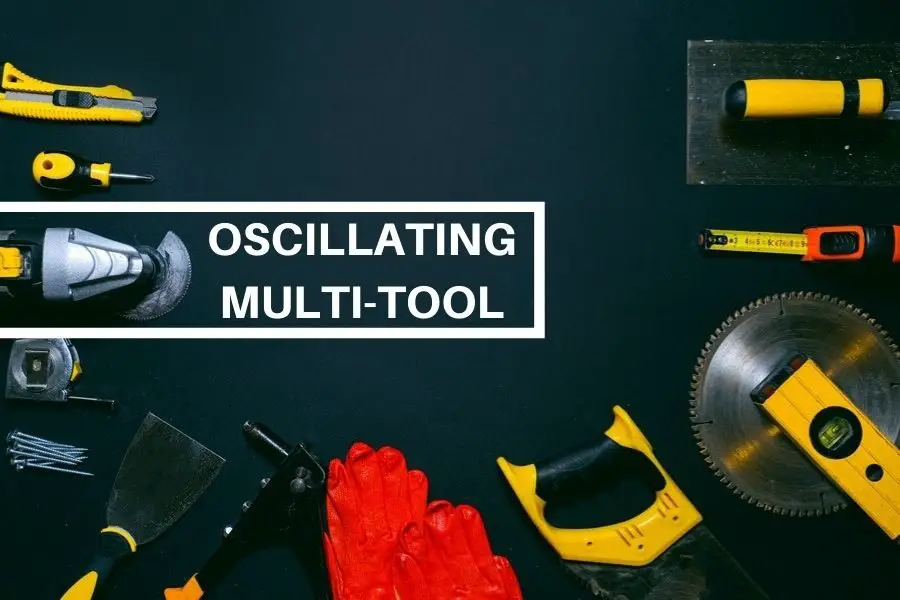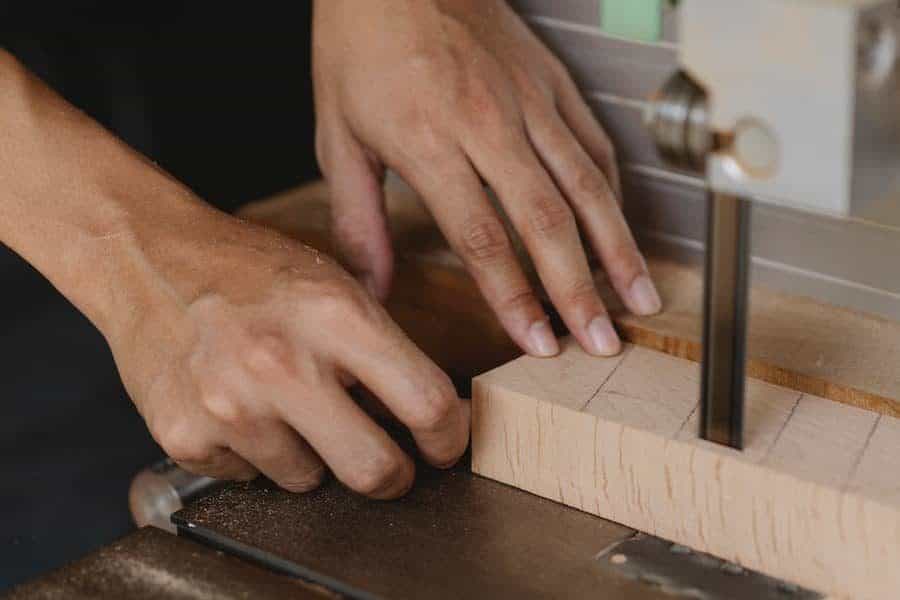Trying to cut Plexiglass has always been a challenge, especially when you don’t do it for a living. There are many techniques and tools on how to perform this task, and not doing it the right way can lead to injuries of your own; always wear safety glasses and gloves when cutting.
When cutting Plexiglass, I recommend using the (Oscillating Multi-Tool) because it is the safest to use of all four tools mentioned. (Below) you will see the four most common tools and blades you can use when it comes to cutting acrylic, commonly known as Plexiglass, including Oscillating multi-tool (Safest and easiest to use), Jigsaw, Bandsaw, and Tablesaw.

When Using an Oscillating Multi-Tool to Cut Plexiglass
The oscillating multi-tool is what I recommend; as I mentioned earlier, it is the safest and easy to use of all four cutting tools mentioned above.
The blade you’ll need when using an oscillating multi-tool to cut Plexiglass is called (HSS Segment Blade); the (HSS Segment Blade) is has this particular shape looking similar to a half-moon shape, as you see in the image below.
This blade is also commonly used for cutting wood, fiberglass, metals, thin sheet metal, drywall, and of course, Plexiglass. Suppose you have an oscillating multi-tool. In that case, you can easily cut Plexiglass, especially if you have a fragile piece of Plexiglass. For example, half a millimeter thick is a fragile material.
If you try to cut it with a knife and then try to bend it, unfortunately, it doesn’t always break straight. Sometimes when you make a small cut, the Plexiglass can break.
Here’s the trick to do when using an oscillating multi-tool; make the groove mark first and not cut through. Then flip the Plexiglass over and complete the cut.
Doing this technique of flipping the Plexiglass to complete the cut will avoid chipping and removing less melted material. If you need to cut a circular design, using an oscillating multi-tool is an ideal and straightforward process.
When Using a Jigsaw to Cut Plexiglass
It is recommended to use a fine-tooth blade, which is best for cutting Plexiglass. When using a jigsaw to cut Plexiglass, the ideal blade to use is: (BOSH T121AF Speed / Metal Blade) typically used to cut metals. Still, the blade did a great job when cutting Plexiglass.
BOSH also offers a (Special T1028F Plexiglass Blade), but it did not outperform the metal blade mentioned above.
Both blades made a clean-cut, but again, the difference between the two blades is that the metal blade removed less melted material when using a jigsaw to cut plexiglass. And the (Special T1028F Plexiglass Blade) was dirtier, which means it will remove more melted material.
In other words, the less molted material the blade removes, the better it is because you can see the line more efficiently when cutting. You can use a stencil to draw a line or use a ruler, depending on what you will do. Make sure to hold the product to a table for safety, and keep your hands away from the blade.
When Using a Benchtop Band Saw to Cut Plexiglass
The band saw is ideal for cutting curved shapes. The advantage of using a bandsaw is that it has a table where you can place the Plexiglass, again making it easy to cut curved designs.
The only disadvantage when using a bandsaw is that the blade is completely exposed, as shown in the image (below). Meaning it doesn’t have a blade guard as a table saw does, making it highly dangerous to operate.

Try to maintain a steady pace while cutting with the bandsaw, and never rush your project when using this machine.
When Using a Table Saw to Cut Plexiglass
The most common way to cut Plexiglass is on the table saw. For best results, I recommend the laser carbide 60-tooth saw blade when using a table saw cut plexiglass.
You can read more about how to choose the right blade for your project here; in this article, you’ll also find some creative ideas on what to do with old saw blades as well.
The table saw provides a perfect and precise cut. You can always adjust the saw blade to a height just above the Plexiglass thickness you have chosen.
Keep your hands steady on both sides of the material and always use a table saw guard. Guide the Plexiglass through the saw by holding it firmly on both sides.
Most table saws are equipped with sliding teeth; this tool can be used when cutting long, thin workpieces. These sliding tees are also adjustable, so you can cut angles if desired.
How to Avoid Plexiglass From Chipping: When using a table saw!
Here is a safe and straightforward two-step method you can use to cut Plexiglass on the table saw to prevent these chippings from occurring.
Place the Plexiglass on the table saw first. Next, take a piece of rigid plywood that is at least as large as the Plexiglass you will cut. And place the piece of plywood over the top of the Plexiglass. Also, use a push block to hold everything down and keep my hand out of harm’s way.
Turn on the table saw. Now, to avoid chipping a corner, start cutting only part of the sheet, then remove it and turn the table saw off.
Next, with the partial cut made, flip the Plexiglass over so that the cut edge is against the crosscut carriage’s back. Do the same with the plywood by turning it over.
Next, cut the entire length of the piece. With this two-step cutting method, you’ll never end the cut at a corner where the Plexiglass is more likely to chip.
And that plywood eliminates all the flutter and what you’re left with is a clean, smooth cut from edge to edge with no chipping or flaking every time.
What Tool is Used to Drill Plexiglass at Home?
Plexiglass drilling at home can be accomplished by using some of the following drill bits:
- Step drill bit (Ideal for short drilling).
- Drill bit for plastic (Ideal for deep drilling) (Most recommended).
- Hole saw pilot drill bit (Ideal for extensive wide drilling).
Of course, you will need a drill driver to use all of the above drill bits (Below) you can learn more about each drill bit mentioned above and how to avoid some mistakes when drilling Plexiglass.
1. When Drilling Plexiglass With Step Drill Bit
The most common uses for step drill bits are in aluminum or sheet metal. Still, you can use a step drill bit for drilling Plexiglass.
You will also see them commonly used when drilling softer materials, such as plywood, particleboard, and laminate. Keep in mind that the Plexiglass cannot be thicker than the step drill depth when drilling. The step drill bit is unique because you can use one drill bit for multiple applications to drill holes for more than one size.
The step drill eliminates the tedious process of changing drill bits between each hole. Most step drill bits are self-drilling, so this should be easy to use. With each pass of the drill bit, you’ll see the hole get bigger and bigger.
The trick to using a step drill bit is to know when to stop drilling. Instead of stopping at each step to measure the hole’s width, use tape and wrap it around the step drill bit at the stage where you want to stop drilling. For example, if you need to stop in a half-inch hole. Keep drilling until you get to the tape.
It’s that easy; it’s fast, simple, and leaves you with a clean hole in your Plexiglass. Be sure to wipe the step drill bit with a soft cloth after use.
You can also use the step drill bit to enlarge existing holes or create a countersink (a tapered, funnel-like hole) in thicker material. You’ll be happy to know that step drills are available in both metric and standard, giving you plenty of options for any situation you may need.
2. When Drilling Plexiglass With Drill Bit for Plastic
It is crucial to note that if the holes are for fasteners, such as screws or bolts, they should be slightly oversized. Plastic expands and contracts with temperature changes; if fastened too tightly or with a too-small hole, cracks are likely to occur. Drilling in Plexiglass requires special commercially available drill bits.
When looking for these drill bits, if you look closely at a standard drill bit and a plastic drill bit, you will see the difference. The most obvious difference is the tip’s shape; a plastic drill bit has a more narrow sharpened tip. The difference is noticeable: a plastic drill bit cuts smoothly without chipping.
3. When Drilling Plexiglass With Hole Saw Bit
When using a hole saw bit, be sure to start drilling into the Plexiglas slowly. First, allow the bit to contact the Plexiglass where you want to drill and mark it. Then stop and re-check and ensure that you are drilling in the correct spot before drilling with the hole saw. After re-evaluating, continue drilling; you want to apply a decent amount of pressure allowing the Plexiglass to melt.
When drilling, build a channel first, and then you can drill through completely. Also, be sure to keep a straight cut; otherwise, the drill will grip. And keep in mind never drill too close to the edge of the Plexiglass; it will get damaged.
For More:
- Read the full article about what tool is best for removing grout.











